HLTAID003 First Aid Theory Assessment
VerifiedAdded on 2019/11/20
|13
|3913
|684
Homework Assignment
AI Summary
This document contains a solved theory assessment for the HLTAID003 Provide first aid course, part of the Diploma of Nursing program. The assessment covers a range of topics including the Good Samaritan law, workplace safety obligations, duty of care for first aiders, consent, and legal factors in providing first aid. It also includes questions on stress management, respiratory patterns, assessing a collapsed person, and the anatomy of the rib cage. Furthermore, the assessment delves into CPR techniques, the chain of survival, secondary surveys, and specific first aid management for various scenarios such as burns, crush injuries, diabetes, dislocations, drowning, hypothermia, heat exhaustion, heat stroke, eye injuries, bleeding, seizures, shock, sprains, strokes, head injuries, spinal injuries, needle stick injuries, poisoning, and toxic inhalation. The document also includes a bibliography of resources used.
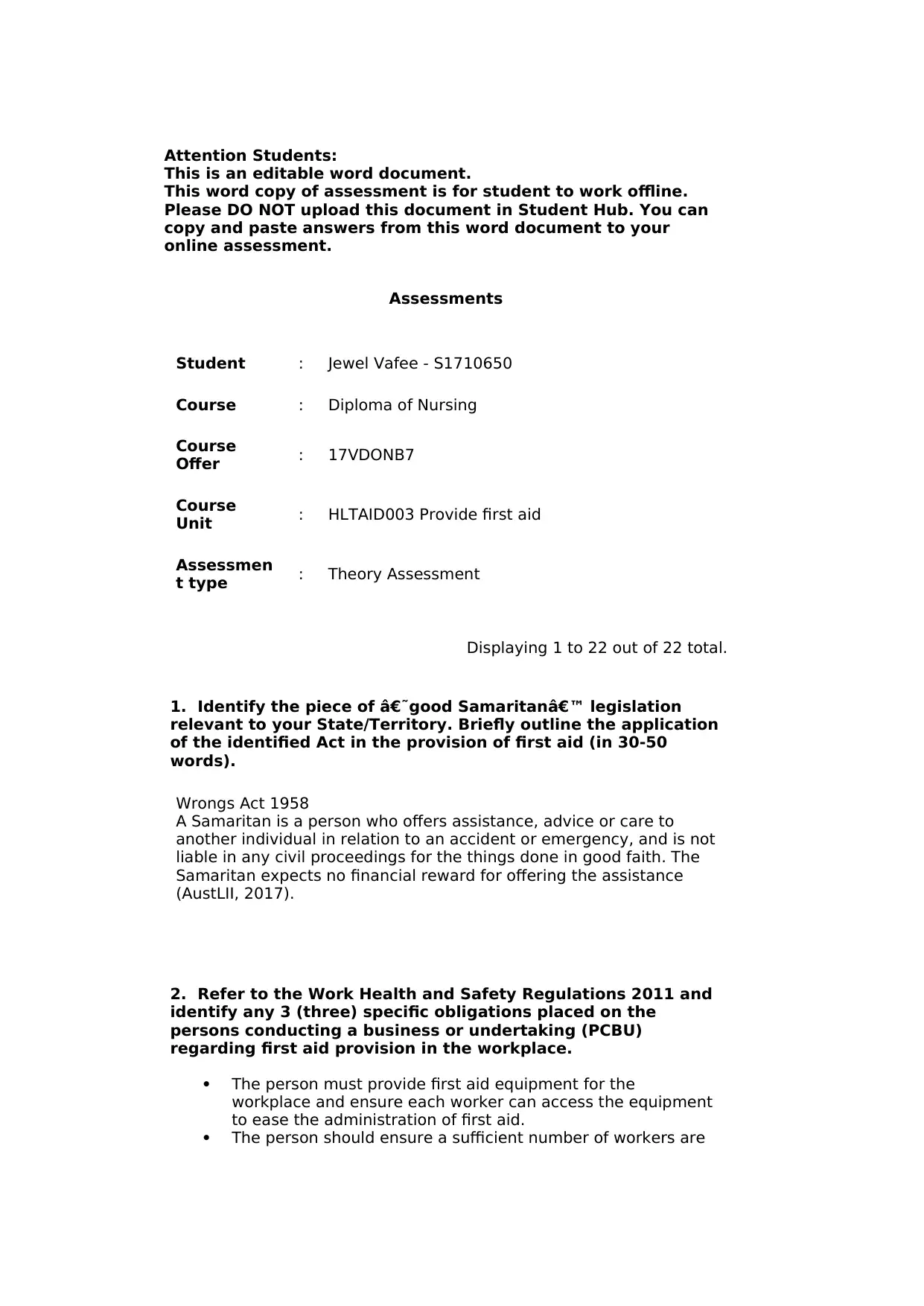
Attention Students:
This is an editable word document.
This word copy of assessment is for student to work offline.
Please DO NOT upload this document in Student Hub. You can
copy and paste answers from this word document to your
online assessment.
Assessments
Student : Jewel Vafee - S1710650
Course : Diploma of Nursing
Course
Offer : 17VDONB7
Course
Unit : HLTAID003 Provide first aid
Assessmen
t type : Theory Assessment
Displaying 1 to 22 out of 22 total.
1. Identify the piece of ‘good Samaritan’ legislation
relevant to your State/Territory. Briefly outline the application
of the identified Act in the provision of first aid (in 30-50
words).
Wrongs Act 1958
A Samaritan is a person who offers assistance, advice or care to
another individual in relation to an accident or emergency, and is not
liable in any civil proceedings for the things done in good faith. The
Samaritan expects no financial reward for offering the assistance
(AustLII, 2017).
2. Refer to the Work Health and Safety Regulations 2011 and
identify any 3 (three) specific obligations placed on the
persons conducting a business or undertaking (PCBU)
regarding first aid provision in the workplace.
The person must provide first aid equipment for the
workplace and ensure each worker can access the equipment
to ease the administration of first aid.
The person should ensure a sufficient number of workers are
This is an editable word document.
This word copy of assessment is for student to work offline.
Please DO NOT upload this document in Student Hub. You can
copy and paste answers from this word document to your
online assessment.
Assessments
Student : Jewel Vafee - S1710650
Course : Diploma of Nursing
Course
Offer : 17VDONB7
Course
Unit : HLTAID003 Provide first aid
Assessmen
t type : Theory Assessment
Displaying 1 to 22 out of 22 total.
1. Identify the piece of ‘good Samaritan’ legislation
relevant to your State/Territory. Briefly outline the application
of the identified Act in the provision of first aid (in 30-50
words).
Wrongs Act 1958
A Samaritan is a person who offers assistance, advice or care to
another individual in relation to an accident or emergency, and is not
liable in any civil proceedings for the things done in good faith. The
Samaritan expects no financial reward for offering the assistance
(AustLII, 2017).
2. Refer to the Work Health and Safety Regulations 2011 and
identify any 3 (three) specific obligations placed on the
persons conducting a business or undertaking (PCBU)
regarding first aid provision in the workplace.
The person must provide first aid equipment for the
workplace and ensure each worker can access the equipment
to ease the administration of first aid.
The person should ensure a sufficient number of workers are
Paraphrase This Document
Need a fresh take? Get an instant paraphrase of this document with our AI Paraphraser

trained to offer first aid.
The person should consider the type of work being carried
out and kind of hazards in the workplace (Federal Register of
Legislation, 2011).
3. What is the duty of care of a trained first aider or trained
volunteer in a first aid situation? (In 30-50 words).
A trained first aider should offer assistance to the injured or ill person
and keep the persons safe before they can get advanced medical
treatment from a health professional. The aider should manage the
situation and make sure there is safety for themselves, bystanders as
well as the casualty.
4. What is the duty of care recommendation by the Australian
and New Zealand Committee on Resuscitation (ANZCOR) for
healthcare professionals who are off-duty in a first aid
situation? (In 30-50 words).
ANZCOR urges health professionals who are off-duty to offer
assistance if asked to do so even when they might have no duty to
offer assistance provided their own safety is guaranteed. This
recommendation is based on the fact that health professionals are
governed by ethical legal and professionals principles (ANZCOR,
2015).
5. Differentiate between expressed and implied consents and
provide an example of each for these 2 (two) types of
consents in the context of provision of first aid (in 60-80
words).
Expressed consent is when a first aider is given explicit
permission by a casualty to offer assistance. This type of
consent can be offered verbally or with a nod of the head
(Thygerson et al., 2011). For example, an injured person
might allow a first aider to dress the wounds.
Implied consent is when a first aider offers assistance to an
unresponsive person. This kind of consent assumes that the
person would consent to lifesaving interventions (Thygerson
et al., 2011). For instance, a first aider might offer care to an
unconscious person after a car accident.
6. Identify 2 (two) legal factors that determine whether first
aid could be provided without consent (reference- ARC
Guideline 10.5 - Legal and Ethical Issues Related to
Resuscitation).
The person should consider the type of work being carried
out and kind of hazards in the workplace (Federal Register of
Legislation, 2011).
3. What is the duty of care of a trained first aider or trained
volunteer in a first aid situation? (In 30-50 words).
A trained first aider should offer assistance to the injured or ill person
and keep the persons safe before they can get advanced medical
treatment from a health professional. The aider should manage the
situation and make sure there is safety for themselves, bystanders as
well as the casualty.
4. What is the duty of care recommendation by the Australian
and New Zealand Committee on Resuscitation (ANZCOR) for
healthcare professionals who are off-duty in a first aid
situation? (In 30-50 words).
ANZCOR urges health professionals who are off-duty to offer
assistance if asked to do so even when they might have no duty to
offer assistance provided their own safety is guaranteed. This
recommendation is based on the fact that health professionals are
governed by ethical legal and professionals principles (ANZCOR,
2015).
5. Differentiate between expressed and implied consents and
provide an example of each for these 2 (two) types of
consents in the context of provision of first aid (in 60-80
words).
Expressed consent is when a first aider is given explicit
permission by a casualty to offer assistance. This type of
consent can be offered verbally or with a nod of the head
(Thygerson et al., 2011). For example, an injured person
might allow a first aider to dress the wounds.
Implied consent is when a first aider offers assistance to an
unresponsive person. This kind of consent assumes that the
person would consent to lifesaving interventions (Thygerson
et al., 2011). For instance, a first aider might offer care to an
unconscious person after a car accident.
6. Identify 2 (two) legal factors that determine whether first
aid could be provided without consent (reference- ARC
Guideline 10.5 - Legal and Ethical Issues Related to
Resuscitation).
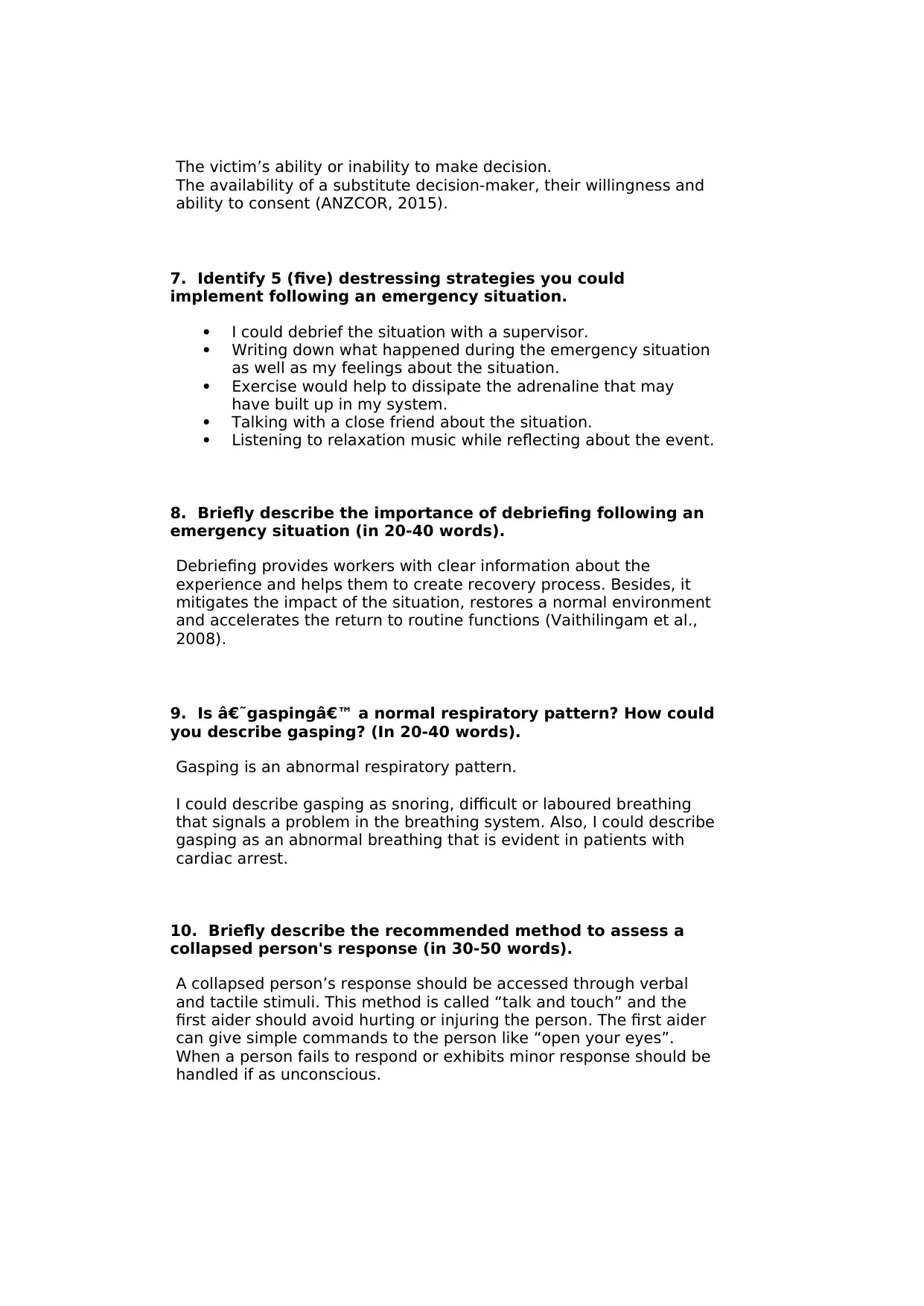
The victim’s ability or inability to make decision.
The availability of a substitute decision-maker, their willingness and
ability to consent (ANZCOR, 2015).
7. Identify 5 (five) destressing strategies you could
implement following an emergency situation.
I could debrief the situation with a supervisor.
Writing down what happened during the emergency situation
as well as my feelings about the situation.
Exercise would help to dissipate the adrenaline that may
have built up in my system.
Talking with a close friend about the situation.
Listening to relaxation music while reflecting about the event.
8. Briefly describe the importance of debriefing following an
emergency situation (in 20-40 words).
Debriefing provides workers with clear information about the
experience and helps them to create recovery process. Besides, it
mitigates the impact of the situation, restores a normal environment
and accelerates the return to routine functions (Vaithilingam et al.,
2008).
9. Is ‘gasping’ a normal respiratory pattern? How could
you describe gasping? (In 20-40 words).
Gasping is an abnormal respiratory pattern.
I could describe gasping as snoring, difficult or laboured breathing
that signals a problem in the breathing system. Also, I could describe
gasping as an abnormal breathing that is evident in patients with
cardiac arrest.
10. Briefly describe the recommended method to assess a
collapsed person's response (in 30-50 words).
A collapsed person’s response should be accessed through verbal
and tactile stimuli. This method is called “talk and touch” and the
first aider should avoid hurting or injuring the person. The first aider
can give simple commands to the person like “open your eyes”.
When a person fails to respond or exhibits minor response should be
handled if as unconscious.
The availability of a substitute decision-maker, their willingness and
ability to consent (ANZCOR, 2015).
7. Identify 5 (five) destressing strategies you could
implement following an emergency situation.
I could debrief the situation with a supervisor.
Writing down what happened during the emergency situation
as well as my feelings about the situation.
Exercise would help to dissipate the adrenaline that may
have built up in my system.
Talking with a close friend about the situation.
Listening to relaxation music while reflecting about the event.
8. Briefly describe the importance of debriefing following an
emergency situation (in 20-40 words).
Debriefing provides workers with clear information about the
experience and helps them to create recovery process. Besides, it
mitigates the impact of the situation, restores a normal environment
and accelerates the return to routine functions (Vaithilingam et al.,
2008).
9. Is ‘gasping’ a normal respiratory pattern? How could
you describe gasping? (In 20-40 words).
Gasping is an abnormal respiratory pattern.
I could describe gasping as snoring, difficult or laboured breathing
that signals a problem in the breathing system. Also, I could describe
gasping as an abnormal breathing that is evident in patients with
cardiac arrest.
10. Briefly describe the recommended method to assess a
collapsed person's response (in 30-50 words).
A collapsed person’s response should be accessed through verbal
and tactile stimuli. This method is called “talk and touch” and the
first aider should avoid hurting or injuring the person. The first aider
can give simple commands to the person like “open your eyes”.
When a person fails to respond or exhibits minor response should be
handled if as unconscious.
⊘ This is a preview!⊘
Do you want full access?
Subscribe today to unlock all pages.

Trusted by 1+ million students worldwide

11. Identify parts of the human rib cage indicated in the
following diagram.
1. Clavicle
2. Body
3. Ribs
4. Xiphoid process
5. Costal cartilage
12. Identify 2 (two) anatomical and physiological changes
occurring to the upper airway of an unconscious person lying
on their back.
Anatomical changes
The trachea (windpipe) might get blocked when an unconscious
person is lying on their back. The tongue plays a key role in blocking
the trachea since it falls against the black wall of the throat.
Nasal passages might also occur because soft tissues of the upper
airways can cause obstruction.
Physiological changes
Airflow is obstructed, which can cause noise or no noise when
breathing
following diagram.
1. Clavicle
2. Body
3. Ribs
4. Xiphoid process
5. Costal cartilage
12. Identify 2 (two) anatomical and physiological changes
occurring to the upper airway of an unconscious person lying
on their back.
Anatomical changes
The trachea (windpipe) might get blocked when an unconscious
person is lying on their back. The tongue plays a key role in blocking
the trachea since it falls against the black wall of the throat.
Nasal passages might also occur because soft tissues of the upper
airways can cause obstruction.
Physiological changes
Airflow is obstructed, which can cause noise or no noise when
breathing
Paraphrase This Document
Need a fresh take? Get an instant paraphrase of this document with our AI Paraphraser

The body lacks sufficient oxygen and turn blue.
13. What happens to a casualty upper airway with the head
tilt/chin lift manoeuvre? (In 20-30 words).
The head tilt-chin lift is an airway manoeuvre used in resuscitation.
Resuscitation through this method is achieved by opening the
obstructed upper airway. During the process, the mouth opens and
the tongue pulls away from the back of the throat. Additionally, the
soft tissues assume their normal position away from the back of the
mouth.
14. What happens to the casualty vital organs during cardio-
pulmonary resuscitation? (In 20-40 words).
When the chest is compressed, inter-thoracic pressure increased,
which compresses the heart and circulates blood through the body.
Since there is some oxygen is bound to the haemoglobin, blood
circulates oxygen to the casualty’s brain and heart tissues.
15. What is the recommended rate of CPR?
ANZCOR recommends rescuers to perform 100 to 120 compressions
per minute for casualties of all ages. The case may be about 2
compressions per second. However, the number of compressions
might be interrupted by breathing. ANZCOR notes that compressions
rates less than 100 or even greater than 140 compressions per
minute are linked to lower rates of survival (ANZCOR, 2016).
16. Provide 3 (three) situations where you could cease
providing CPR to a casualty.
If the casualty shows signs of life. This can happen when an
Automated External Defibrillator (AED) is used.
In case the scene becomes unsafe, CPR should be ceased to
seek safety.
In case of exhaustion CPR should be ceased.
17. Identify the 4 (four) links within the chain of survival.
Early (immediate) recognition of cardiac arrest and activation of the
13. What happens to a casualty upper airway with the head
tilt/chin lift manoeuvre? (In 20-30 words).
The head tilt-chin lift is an airway manoeuvre used in resuscitation.
Resuscitation through this method is achieved by opening the
obstructed upper airway. During the process, the mouth opens and
the tongue pulls away from the back of the throat. Additionally, the
soft tissues assume their normal position away from the back of the
mouth.
14. What happens to the casualty vital organs during cardio-
pulmonary resuscitation? (In 20-40 words).
When the chest is compressed, inter-thoracic pressure increased,
which compresses the heart and circulates blood through the body.
Since there is some oxygen is bound to the haemoglobin, blood
circulates oxygen to the casualty’s brain and heart tissues.
15. What is the recommended rate of CPR?
ANZCOR recommends rescuers to perform 100 to 120 compressions
per minute for casualties of all ages. The case may be about 2
compressions per second. However, the number of compressions
might be interrupted by breathing. ANZCOR notes that compressions
rates less than 100 or even greater than 140 compressions per
minute are linked to lower rates of survival (ANZCOR, 2016).
16. Provide 3 (three) situations where you could cease
providing CPR to a casualty.
If the casualty shows signs of life. This can happen when an
Automated External Defibrillator (AED) is used.
In case the scene becomes unsafe, CPR should be ceased to
seek safety.
In case of exhaustion CPR should be ceased.
17. Identify the 4 (four) links within the chain of survival.
Early (immediate) recognition of cardiac arrest and activation of the
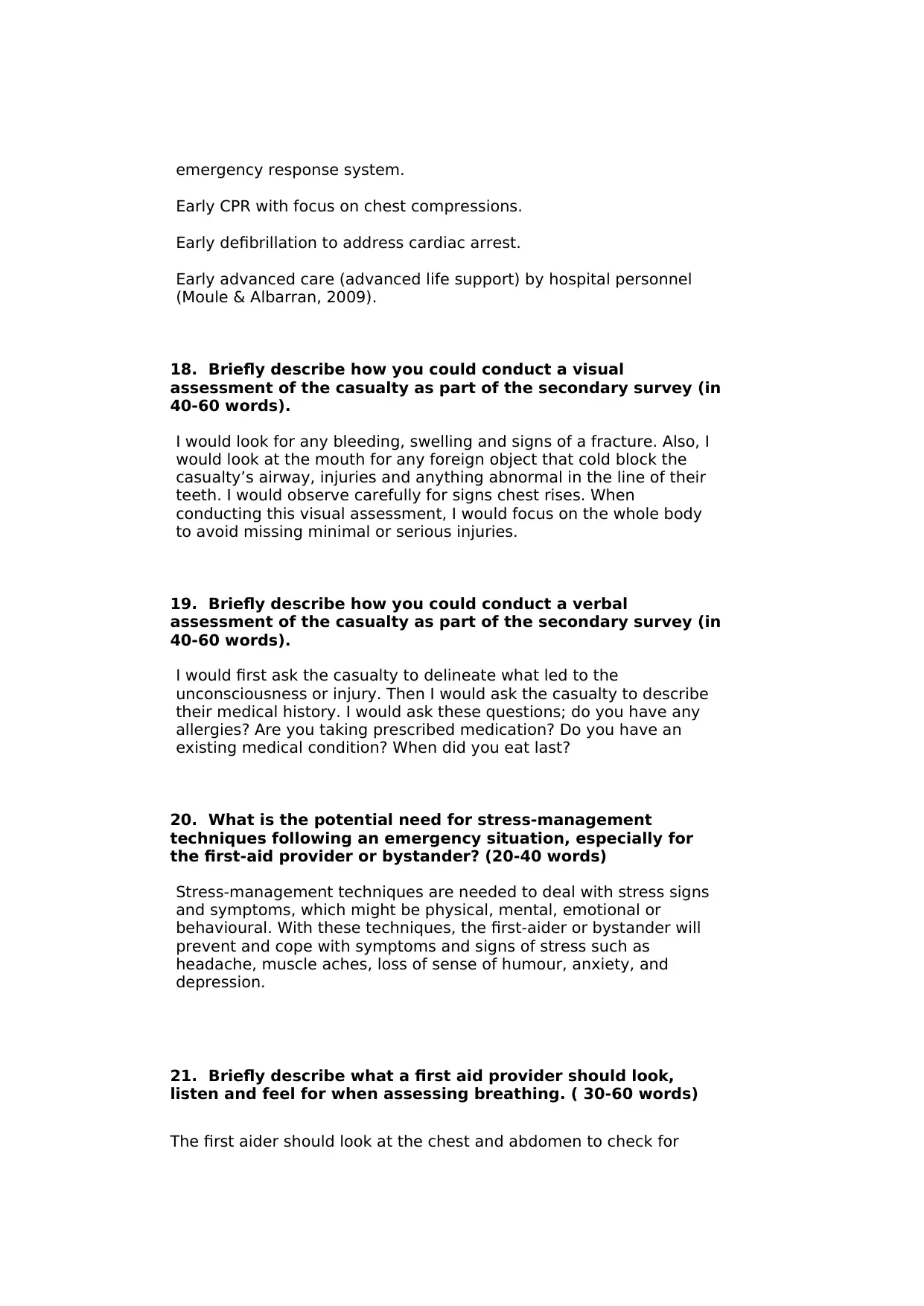
emergency response system.
Early CPR with focus on chest compressions.
Early defibrillation to address cardiac arrest.
Early advanced care (advanced life support) by hospital personnel
(Moule & Albarran, 2009).
18. Briefly describe how you could conduct a visual
assessment of the casualty as part of the secondary survey (in
40-60 words).
I would look for any bleeding, swelling and signs of a fracture. Also, I
would look at the mouth for any foreign object that cold block the
casualty’s airway, injuries and anything abnormal in the line of their
teeth. I would observe carefully for signs chest rises. When
conducting this visual assessment, I would focus on the whole body
to avoid missing minimal or serious injuries.
19. Briefly describe how you could conduct a verbal
assessment of the casualty as part of the secondary survey (in
40-60 words).
I would first ask the casualty to delineate what led to the
unconsciousness or injury. Then I would ask the casualty to describe
their medical history. I would ask these questions; do you have any
allergies? Are you taking prescribed medication? Do you have an
existing medical condition? When did you eat last?
20. What is the potential need for stress-management
techniques following an emergency situation, especially for
the first-aid provider or bystander? (20-40 words)
Stress-management techniques are needed to deal with stress signs
and symptoms, which might be physical, mental, emotional or
behavioural. With these techniques, the first-aider or bystander will
prevent and cope with symptoms and signs of stress such as
headache, muscle aches, loss of sense of humour, anxiety, and
depression.
21. Briefly describe what a first aid provider should look,
listen and feel for when assessing breathing. ( 30-60 words)
The first aider should look at the chest and abdomen to check for
Early CPR with focus on chest compressions.
Early defibrillation to address cardiac arrest.
Early advanced care (advanced life support) by hospital personnel
(Moule & Albarran, 2009).
18. Briefly describe how you could conduct a visual
assessment of the casualty as part of the secondary survey (in
40-60 words).
I would look for any bleeding, swelling and signs of a fracture. Also, I
would look at the mouth for any foreign object that cold block the
casualty’s airway, injuries and anything abnormal in the line of their
teeth. I would observe carefully for signs chest rises. When
conducting this visual assessment, I would focus on the whole body
to avoid missing minimal or serious injuries.
19. Briefly describe how you could conduct a verbal
assessment of the casualty as part of the secondary survey (in
40-60 words).
I would first ask the casualty to delineate what led to the
unconsciousness or injury. Then I would ask the casualty to describe
their medical history. I would ask these questions; do you have any
allergies? Are you taking prescribed medication? Do you have an
existing medical condition? When did you eat last?
20. What is the potential need for stress-management
techniques following an emergency situation, especially for
the first-aid provider or bystander? (20-40 words)
Stress-management techniques are needed to deal with stress signs
and symptoms, which might be physical, mental, emotional or
behavioural. With these techniques, the first-aider or bystander will
prevent and cope with symptoms and signs of stress such as
headache, muscle aches, loss of sense of humour, anxiety, and
depression.
21. Briefly describe what a first aid provider should look,
listen and feel for when assessing breathing. ( 30-60 words)
The first aider should look at the chest and abdomen to check for
⊘ This is a preview!⊘
Do you want full access?
Subscribe today to unlock all pages.

Trusted by 1+ million students worldwide
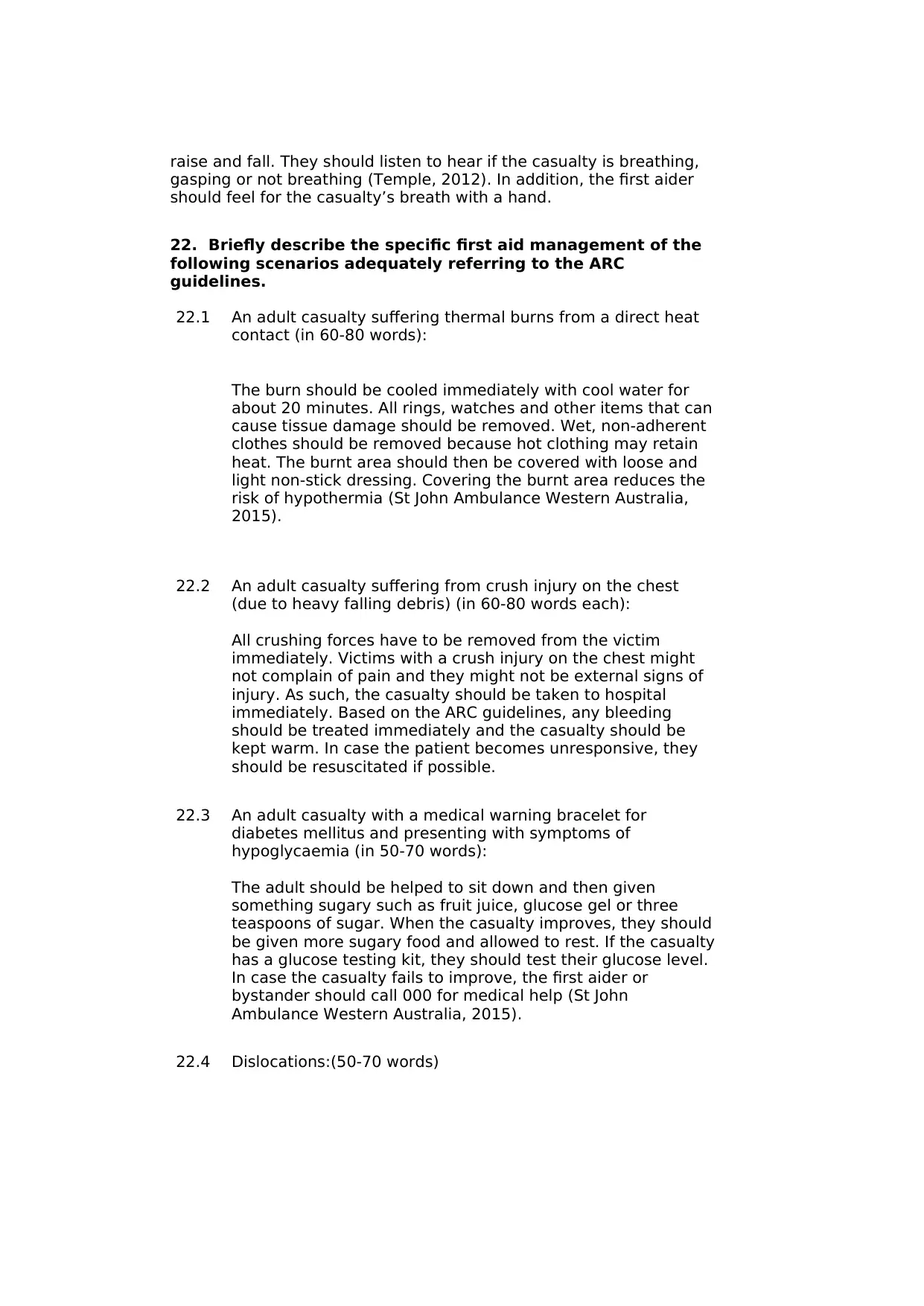
raise and fall. They should listen to hear if the casualty is breathing,
gasping or not breathing (Temple, 2012). In addition, the first aider
should feel for the casualty’s breath with a hand.
22. Briefly describe the specific first aid management of the
following scenarios adequately referring to the ARC
guidelines.
22.1 An adult casualty suffering thermal burns from a direct heat
contact (in 60-80 words):
The burn should be cooled immediately with cool water for
about 20 minutes. All rings, watches and other items that can
cause tissue damage should be removed. Wet, non-adherent
clothes should be removed because hot clothing may retain
heat. The burnt area should then be covered with loose and
light non-stick dressing. Covering the burnt area reduces the
risk of hypothermia (St John Ambulance Western Australia,
2015).
22.2 An adult casualty suffering from crush injury on the chest
(due to heavy falling debris) (in 60-80 words each):
All crushing forces have to be removed from the victim
immediately. Victims with a crush injury on the chest might
not complain of pain and they might not be external signs of
injury. As such, the casualty should be taken to hospital
immediately. Based on the ARC guidelines, any bleeding
should be treated immediately and the casualty should be
kept warm. In case the patient becomes unresponsive, they
should be resuscitated if possible.
22.3 An adult casualty with a medical warning bracelet for
diabetes mellitus and presenting with symptoms of
hypoglycaemia (in 50-70 words):
The adult should be helped to sit down and then given
something sugary such as fruit juice, glucose gel or three
teaspoons of sugar. When the casualty improves, they should
be given more sugary food and allowed to rest. If the casualty
has a glucose testing kit, they should test their glucose level.
In case the casualty fails to improve, the first aider or
bystander should call 000 for medical help (St John
Ambulance Western Australia, 2015).
22.4 Dislocations:(50-70 words)
gasping or not breathing (Temple, 2012). In addition, the first aider
should feel for the casualty’s breath with a hand.
22. Briefly describe the specific first aid management of the
following scenarios adequately referring to the ARC
guidelines.
22.1 An adult casualty suffering thermal burns from a direct heat
contact (in 60-80 words):
The burn should be cooled immediately with cool water for
about 20 minutes. All rings, watches and other items that can
cause tissue damage should be removed. Wet, non-adherent
clothes should be removed because hot clothing may retain
heat. The burnt area should then be covered with loose and
light non-stick dressing. Covering the burnt area reduces the
risk of hypothermia (St John Ambulance Western Australia,
2015).
22.2 An adult casualty suffering from crush injury on the chest
(due to heavy falling debris) (in 60-80 words each):
All crushing forces have to be removed from the victim
immediately. Victims with a crush injury on the chest might
not complain of pain and they might not be external signs of
injury. As such, the casualty should be taken to hospital
immediately. Based on the ARC guidelines, any bleeding
should be treated immediately and the casualty should be
kept warm. In case the patient becomes unresponsive, they
should be resuscitated if possible.
22.3 An adult casualty with a medical warning bracelet for
diabetes mellitus and presenting with symptoms of
hypoglycaemia (in 50-70 words):
The adult should be helped to sit down and then given
something sugary such as fruit juice, glucose gel or three
teaspoons of sugar. When the casualty improves, they should
be given more sugary food and allowed to rest. If the casualty
has a glucose testing kit, they should test their glucose level.
In case the casualty fails to improve, the first aider or
bystander should call 000 for medical help (St John
Ambulance Western Australia, 2015).
22.4 Dislocations:(50-70 words)
Paraphrase This Document
Need a fresh take? Get an instant paraphrase of this document with our AI Paraphraser
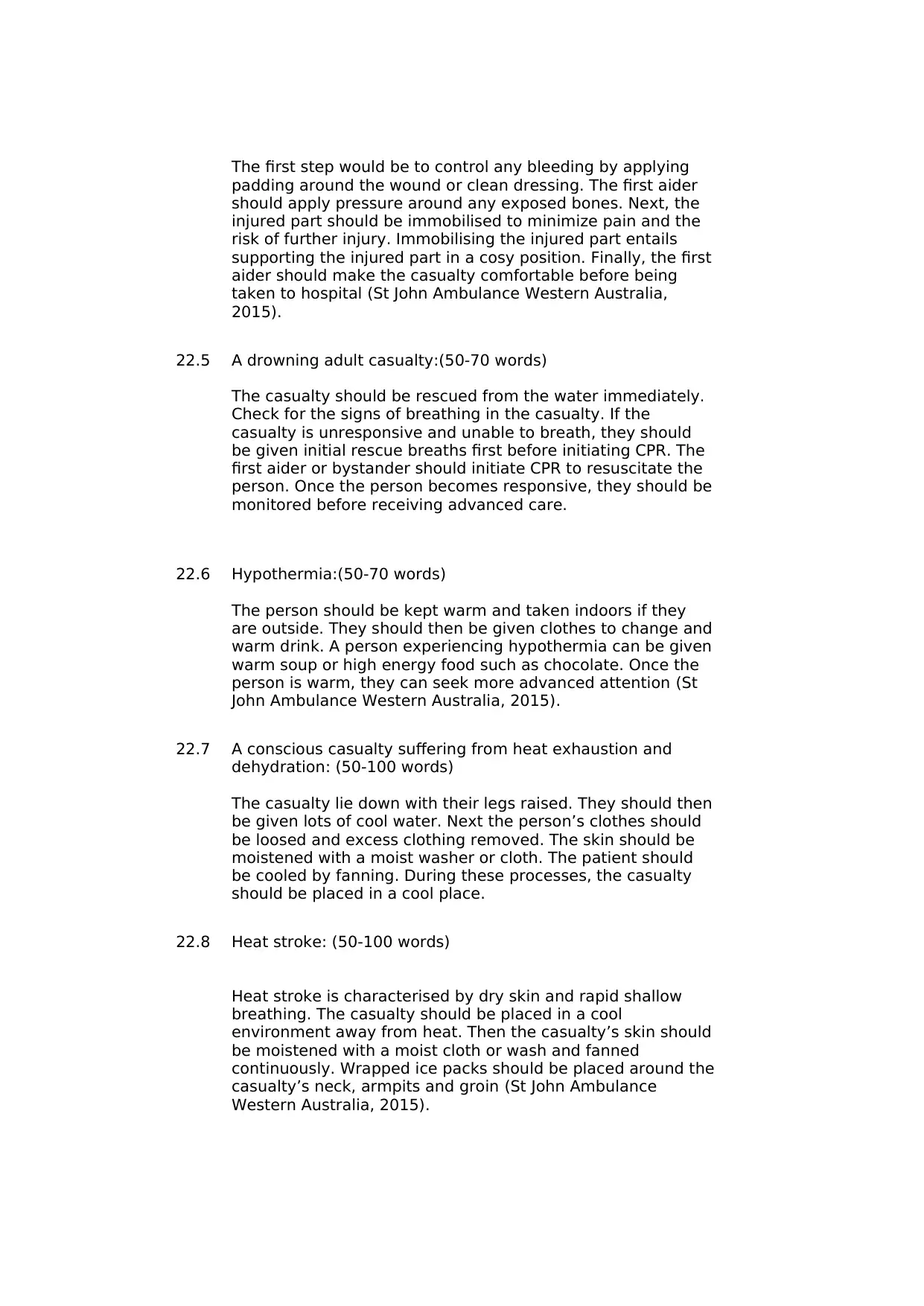
The first step would be to control any bleeding by applying
padding around the wound or clean dressing. The first aider
should apply pressure around any exposed bones. Next, the
injured part should be immobilised to minimize pain and the
risk of further injury. Immobilising the injured part entails
supporting the injured part in a cosy position. Finally, the first
aider should make the casualty comfortable before being
taken to hospital (St John Ambulance Western Australia,
2015).
22.5 A drowning adult casualty:(50-70 words)
The casualty should be rescued from the water immediately.
Check for the signs of breathing in the casualty. If the
casualty is unresponsive and unable to breath, they should
be given initial rescue breaths first before initiating CPR. The
first aider or bystander should initiate CPR to resuscitate the
person. Once the person becomes responsive, they should be
monitored before receiving advanced care.
22.6 Hypothermia:(50-70 words)
The person should be kept warm and taken indoors if they
are outside. They should then be given clothes to change and
warm drink. A person experiencing hypothermia can be given
warm soup or high energy food such as chocolate. Once the
person is warm, they can seek more advanced attention (St
John Ambulance Western Australia, 2015).
22.7 A conscious casualty suffering from heat exhaustion and
dehydration: (50-100 words)
The casualty lie down with their legs raised. They should then
be given lots of cool water. Next the person’s clothes should
be loosed and excess clothing removed. The skin should be
moistened with a moist washer or cloth. The patient should
be cooled by fanning. During these processes, the casualty
should be placed in a cool place.
22.8 Heat stroke: (50-100 words)
Heat stroke is characterised by dry skin and rapid shallow
breathing. The casualty should be placed in a cool
environment away from heat. Then the casualty’s skin should
be moistened with a moist cloth or wash and fanned
continuously. Wrapped ice packs should be placed around the
casualty’s neck, armpits and groin (St John Ambulance
Western Australia, 2015).
padding around the wound or clean dressing. The first aider
should apply pressure around any exposed bones. Next, the
injured part should be immobilised to minimize pain and the
risk of further injury. Immobilising the injured part entails
supporting the injured part in a cosy position. Finally, the first
aider should make the casualty comfortable before being
taken to hospital (St John Ambulance Western Australia,
2015).
22.5 A drowning adult casualty:(50-70 words)
The casualty should be rescued from the water immediately.
Check for the signs of breathing in the casualty. If the
casualty is unresponsive and unable to breath, they should
be given initial rescue breaths first before initiating CPR. The
first aider or bystander should initiate CPR to resuscitate the
person. Once the person becomes responsive, they should be
monitored before receiving advanced care.
22.6 Hypothermia:(50-70 words)
The person should be kept warm and taken indoors if they
are outside. They should then be given clothes to change and
warm drink. A person experiencing hypothermia can be given
warm soup or high energy food such as chocolate. Once the
person is warm, they can seek more advanced attention (St
John Ambulance Western Australia, 2015).
22.7 A conscious casualty suffering from heat exhaustion and
dehydration: (50-100 words)
The casualty lie down with their legs raised. They should then
be given lots of cool water. Next the person’s clothes should
be loosed and excess clothing removed. The skin should be
moistened with a moist washer or cloth. The patient should
be cooled by fanning. During these processes, the casualty
should be placed in a cool place.
22.8 Heat stroke: (50-100 words)
Heat stroke is characterised by dry skin and rapid shallow
breathing. The casualty should be placed in a cool
environment away from heat. Then the casualty’s skin should
be moistened with a moist cloth or wash and fanned
continuously. Wrapped ice packs should be placed around the
casualty’s neck, armpits and groin (St John Ambulance
Western Australia, 2015).

22.9 Scald injury of eyes: (50-80 words)
The eyelid should be opened carefully and washed with cold
flowing water for approximately 20 minutes (St John
Ambulance Western Australia, 2015). A light clean dressing or
pad should be placed over the injured eye only. The patient
should be assisted to lie in comfortable position and should
avoid rolling the eye. An ambulance can then be called by
dialling 000.
22.1
0
Bleeding left ear after diving: (50-100 words)
A pad should be placed gently over the ear. Avoid
placing the pad inside the ear.
The person should lie on the left side to ensure the
bleeding ear is facing the ground to allow the blood to
drain outward.
The casualty should be calmed and reassured, but the
incidence should be handled like a serious head injury.
An ambulance or paramedic should then be called
through 000.
22.1
1
A child experiencing febrile convulsions:( 50-100 words)
The child should be placed on the ground gently. Any
close objects should be placed away.
Nothing should be forced into the child’s mouth and
they should not be shaken.
They should also not be slapped or restrained.
The child should then be placed on their side to
prevent choking (St John Ambulance Western
Australia, 2015).
The child should then be examined by a doctor.
22.1
2
Management of epilepsy (the first seizure episode lasted for
five or more minutes and a second seizure quickly followed
the first): (50-100 words)
An ambulance should be called since the last seizure
The eyelid should be opened carefully and washed with cold
flowing water for approximately 20 minutes (St John
Ambulance Western Australia, 2015). A light clean dressing or
pad should be placed over the injured eye only. The patient
should be assisted to lie in comfortable position and should
avoid rolling the eye. An ambulance can then be called by
dialling 000.
22.1
0
Bleeding left ear after diving: (50-100 words)
A pad should be placed gently over the ear. Avoid
placing the pad inside the ear.
The person should lie on the left side to ensure the
bleeding ear is facing the ground to allow the blood to
drain outward.
The casualty should be calmed and reassured, but the
incidence should be handled like a serious head injury.
An ambulance or paramedic should then be called
through 000.
22.1
1
A child experiencing febrile convulsions:( 50-100 words)
The child should be placed on the ground gently. Any
close objects should be placed away.
Nothing should be forced into the child’s mouth and
they should not be shaken.
They should also not be slapped or restrained.
The child should then be placed on their side to
prevent choking (St John Ambulance Western
Australia, 2015).
The child should then be examined by a doctor.
22.1
2
Management of epilepsy (the first seizure episode lasted for
five or more minutes and a second seizure quickly followed
the first): (50-100 words)
An ambulance should be called since the last seizure
⊘ This is a preview!⊘
Do you want full access?
Subscribe today to unlock all pages.

Trusted by 1+ million students worldwide
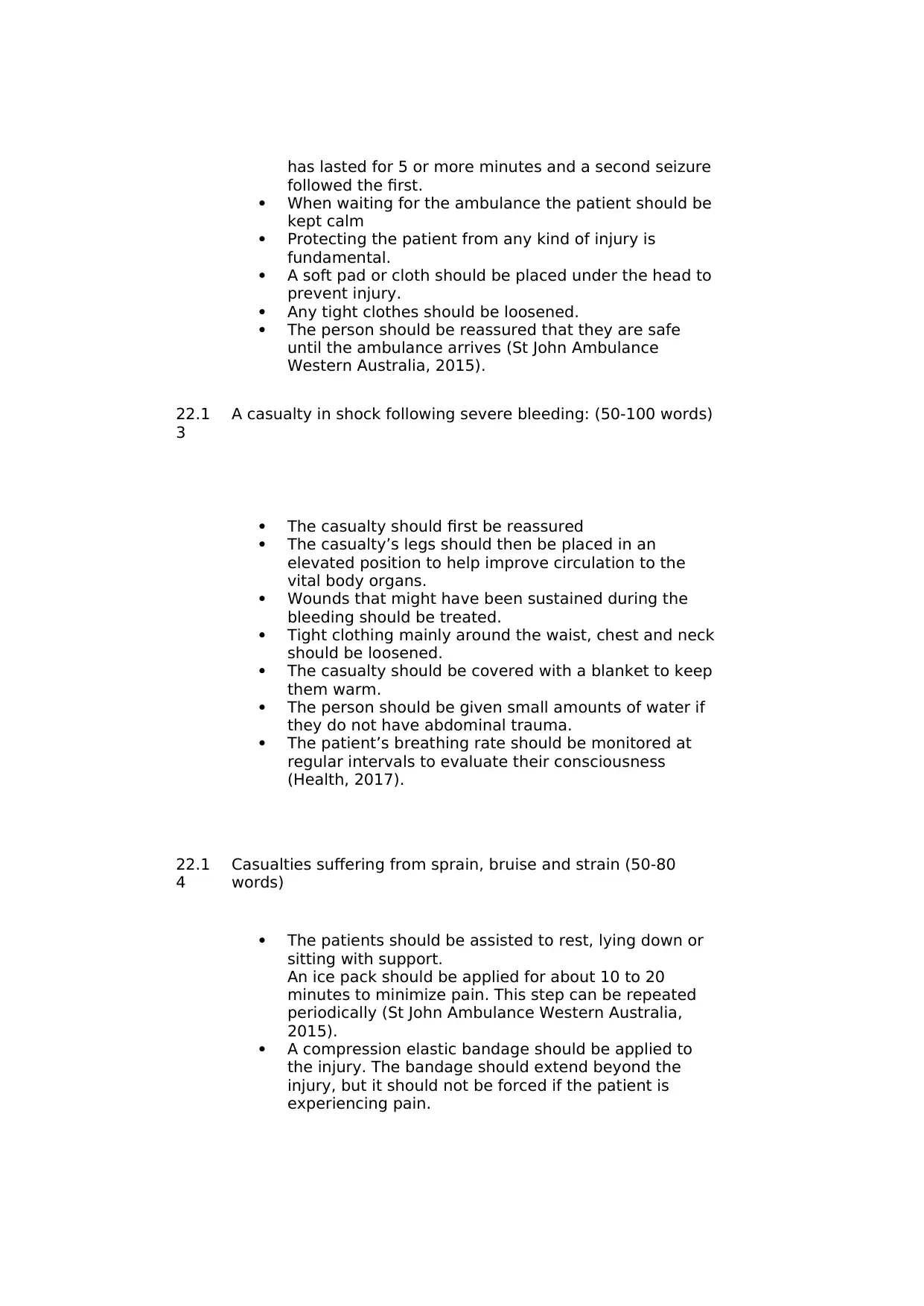
has lasted for 5 or more minutes and a second seizure
followed the first.
When waiting for the ambulance the patient should be
kept calm
Protecting the patient from any kind of injury is
fundamental.
A soft pad or cloth should be placed under the head to
prevent injury.
Any tight clothes should be loosened.
The person should be reassured that they are safe
until the ambulance arrives (St John Ambulance
Western Australia, 2015).
22.1
3
A casualty in shock following severe bleeding: (50-100 words)
The casualty should first be reassured
The casualty’s legs should then be placed in an
elevated position to help improve circulation to the
vital body organs.
Wounds that might have been sustained during the
bleeding should be treated.
Tight clothing mainly around the waist, chest and neck
should be loosened.
The casualty should be covered with a blanket to keep
them warm.
The person should be given small amounts of water if
they do not have abdominal trauma.
The patient’s breathing rate should be monitored at
regular intervals to evaluate their consciousness
(Health, 2017).
22.1
4
Casualties suffering from sprain, bruise and strain (50-80
words)
The patients should be assisted to rest, lying down or
sitting with support.
An ice pack should be applied for about 10 to 20
minutes to minimize pain. This step can be repeated
periodically (St John Ambulance Western Australia,
2015).
A compression elastic bandage should be applied to
the injury. The bandage should extend beyond the
injury, but it should not be forced if the patient is
experiencing pain.
followed the first.
When waiting for the ambulance the patient should be
kept calm
Protecting the patient from any kind of injury is
fundamental.
A soft pad or cloth should be placed under the head to
prevent injury.
Any tight clothes should be loosened.
The person should be reassured that they are safe
until the ambulance arrives (St John Ambulance
Western Australia, 2015).
22.1
3
A casualty in shock following severe bleeding: (50-100 words)
The casualty should first be reassured
The casualty’s legs should then be placed in an
elevated position to help improve circulation to the
vital body organs.
Wounds that might have been sustained during the
bleeding should be treated.
Tight clothing mainly around the waist, chest and neck
should be loosened.
The casualty should be covered with a blanket to keep
them warm.
The person should be given small amounts of water if
they do not have abdominal trauma.
The patient’s breathing rate should be monitored at
regular intervals to evaluate their consciousness
(Health, 2017).
22.1
4
Casualties suffering from sprain, bruise and strain (50-80
words)
The patients should be assisted to rest, lying down or
sitting with support.
An ice pack should be applied for about 10 to 20
minutes to minimize pain. This step can be repeated
periodically (St John Ambulance Western Australia,
2015).
A compression elastic bandage should be applied to
the injury. The bandage should extend beyond the
injury, but it should not be forced if the patient is
experiencing pain.
Paraphrase This Document
Need a fresh take? Get an instant paraphrase of this document with our AI Paraphraser
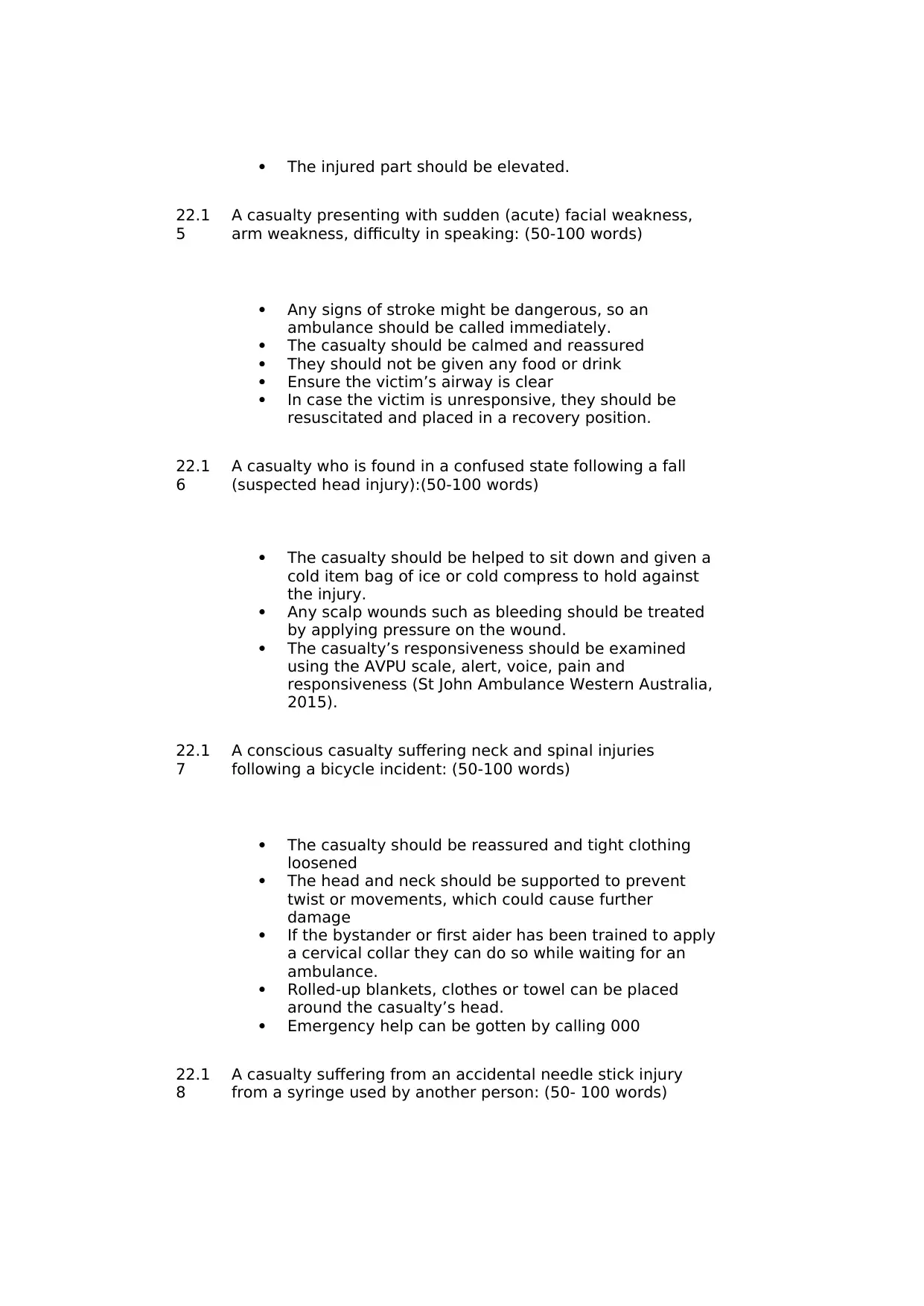
The injured part should be elevated.
22.1
5
A casualty presenting with sudden (acute) facial weakness,
arm weakness, difficulty in speaking: (50-100 words)
Any signs of stroke might be dangerous, so an
ambulance should be called immediately.
The casualty should be calmed and reassured
They should not be given any food or drink
Ensure the victim’s airway is clear
In case the victim is unresponsive, they should be
resuscitated and placed in a recovery position.
22.1
6
A casualty who is found in a confused state following a fall
(suspected head injury):(50-100 words)
The casualty should be helped to sit down and given a
cold item bag of ice or cold compress to hold against
the injury.
Any scalp wounds such as bleeding should be treated
by applying pressure on the wound.
The casualty’s responsiveness should be examined
using the AVPU scale, alert, voice, pain and
responsiveness (St John Ambulance Western Australia,
2015).
22.1
7
A conscious casualty suffering neck and spinal injuries
following a bicycle incident: (50-100 words)
The casualty should be reassured and tight clothing
loosened
The head and neck should be supported to prevent
twist or movements, which could cause further
damage
If the bystander or first aider has been trained to apply
a cervical collar they can do so while waiting for an
ambulance.
Rolled-up blankets, clothes or towel can be placed
around the casualty’s head.
Emergency help can be gotten by calling 000
22.1
8
A casualty suffering from an accidental needle stick injury
from a syringe used by another person: (50- 100 words)
22.1
5
A casualty presenting with sudden (acute) facial weakness,
arm weakness, difficulty in speaking: (50-100 words)
Any signs of stroke might be dangerous, so an
ambulance should be called immediately.
The casualty should be calmed and reassured
They should not be given any food or drink
Ensure the victim’s airway is clear
In case the victim is unresponsive, they should be
resuscitated and placed in a recovery position.
22.1
6
A casualty who is found in a confused state following a fall
(suspected head injury):(50-100 words)
The casualty should be helped to sit down and given a
cold item bag of ice or cold compress to hold against
the injury.
Any scalp wounds such as bleeding should be treated
by applying pressure on the wound.
The casualty’s responsiveness should be examined
using the AVPU scale, alert, voice, pain and
responsiveness (St John Ambulance Western Australia,
2015).
22.1
7
A conscious casualty suffering neck and spinal injuries
following a bicycle incident: (50-100 words)
The casualty should be reassured and tight clothing
loosened
The head and neck should be supported to prevent
twist or movements, which could cause further
damage
If the bystander or first aider has been trained to apply
a cervical collar they can do so while waiting for an
ambulance.
Rolled-up blankets, clothes or towel can be placed
around the casualty’s head.
Emergency help can be gotten by calling 000
22.1
8
A casualty suffering from an accidental needle stick injury
from a syringe used by another person: (50- 100 words)
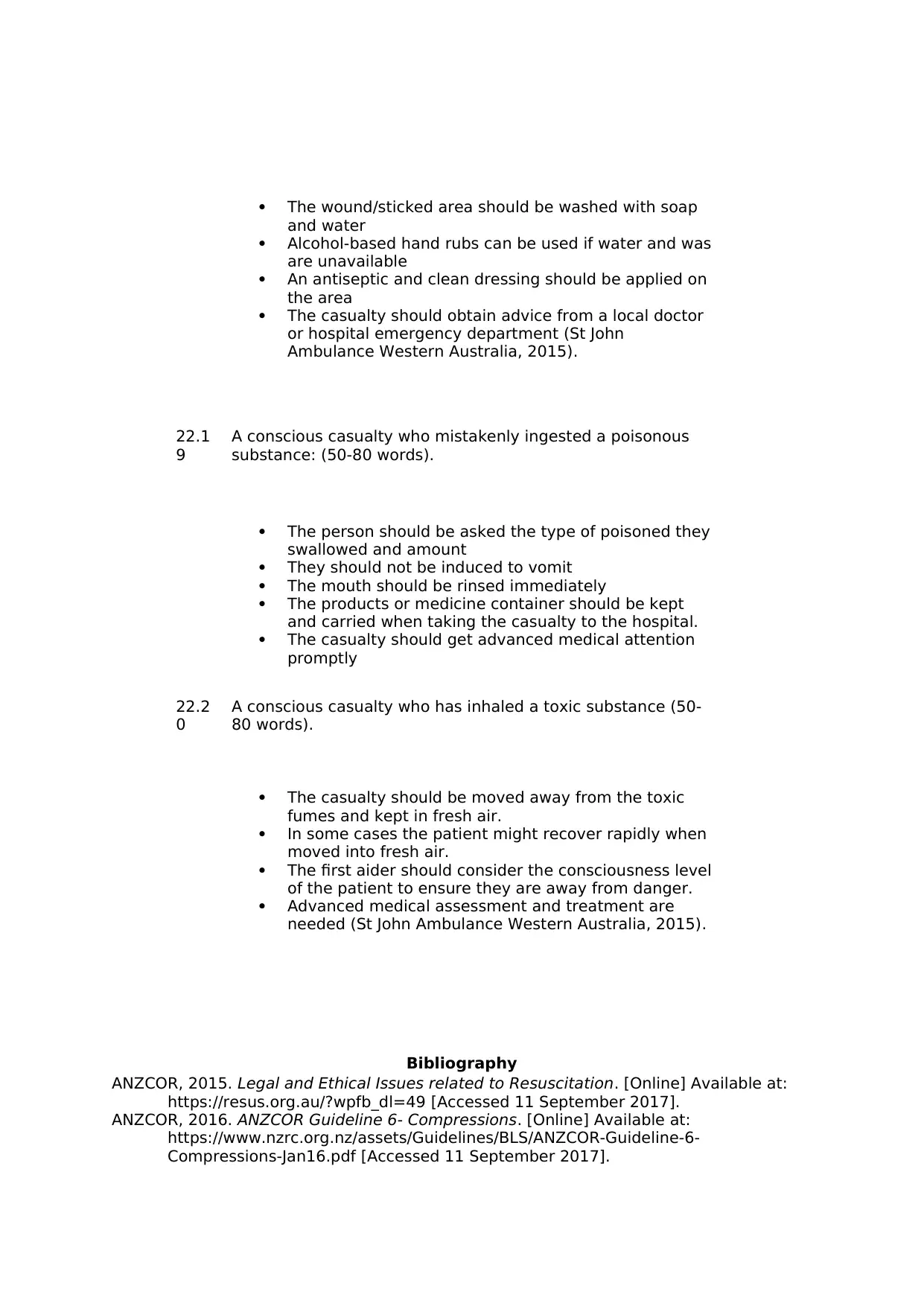
The wound/sticked area should be washed with soap
and water
Alcohol-based hand rubs can be used if water and was
are unavailable
An antiseptic and clean dressing should be applied on
the area
The casualty should obtain advice from a local doctor
or hospital emergency department (St John
Ambulance Western Australia, 2015).
22.1
9
A conscious casualty who mistakenly ingested a poisonous
substance: (50-80 words).
The person should be asked the type of poisoned they
swallowed and amount
They should not be induced to vomit
The mouth should be rinsed immediately
The products or medicine container should be kept
and carried when taking the casualty to the hospital.
The casualty should get advanced medical attention
promptly
22.2
0
A conscious casualty who has inhaled a toxic substance (50-
80 words).
The casualty should be moved away from the toxic
fumes and kept in fresh air.
In some cases the patient might recover rapidly when
moved into fresh air.
The first aider should consider the consciousness level
of the patient to ensure they are away from danger.
Advanced medical assessment and treatment are
needed (St John Ambulance Western Australia, 2015).
Bibliography
ANZCOR, 2015. Legal and Ethical Issues related to Resuscitation. [Online] Available at:
https://resus.org.au/?wpfb_dl=49 [Accessed 11 September 2017].
ANZCOR, 2016. ANZCOR Guideline 6- Compressions. [Online] Available at:
https://www.nzrc.org.nz/assets/Guidelines/BLS/ANZCOR-Guideline-6-
Compressions-Jan16.pdf [Accessed 11 September 2017].
and water
Alcohol-based hand rubs can be used if water and was
are unavailable
An antiseptic and clean dressing should be applied on
the area
The casualty should obtain advice from a local doctor
or hospital emergency department (St John
Ambulance Western Australia, 2015).
22.1
9
A conscious casualty who mistakenly ingested a poisonous
substance: (50-80 words).
The person should be asked the type of poisoned they
swallowed and amount
They should not be induced to vomit
The mouth should be rinsed immediately
The products or medicine container should be kept
and carried when taking the casualty to the hospital.
The casualty should get advanced medical attention
promptly
22.2
0
A conscious casualty who has inhaled a toxic substance (50-
80 words).
The casualty should be moved away from the toxic
fumes and kept in fresh air.
In some cases the patient might recover rapidly when
moved into fresh air.
The first aider should consider the consciousness level
of the patient to ensure they are away from danger.
Advanced medical assessment and treatment are
needed (St John Ambulance Western Australia, 2015).
Bibliography
ANZCOR, 2015. Legal and Ethical Issues related to Resuscitation. [Online] Available at:
https://resus.org.au/?wpfb_dl=49 [Accessed 11 September 2017].
ANZCOR, 2016. ANZCOR Guideline 6- Compressions. [Online] Available at:
https://www.nzrc.org.nz/assets/Guidelines/BLS/ANZCOR-Guideline-6-
Compressions-Jan16.pdf [Accessed 11 September 2017].
⊘ This is a preview!⊘
Do you want full access?
Subscribe today to unlock all pages.

Trusted by 1+ million students worldwide
1 out of 13
Related Documents
Your All-in-One AI-Powered Toolkit for Academic Success.
+13062052269
info@desklib.com
Available 24*7 on WhatsApp / Email
![[object Object]](/_next/static/media/star-bottom.7253800d.svg)
Unlock your academic potential
Copyright © 2020–2025 A2Z Services. All Rights Reserved. Developed and managed by ZUCOL.





